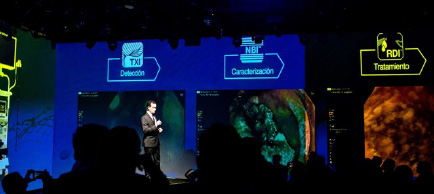Olympus Latin America Showcases Next-Generation EVIS X1 Endoscopy System During Mexico City Launch Event

MIAMI, Fl. (January 22, 2024) – Olympus Latin America announced today that it recently introduced healthcare professionals in Mexico to the next generation EVIS X1™ endoscopy system during a launch event held in Mexico City.
Olympus Latin America provided physicians, nurses and biomedical engineers attending the event hands-on demonstrations of Olympus’ most advanced endoscopy system. Attendees also saw examples of clinical images that are possible with the EVIS X1 endoscopy system and heard physician feedback on its newest visualization modalities that can assist doctors in the detection and treatment of gastrointestinal disorders. The event was attended by more than 150 healthcare professionals.
Full market availability of the EVIS X1 endoscopy system in Latin America is expected over the coming months.
“Physicians need the best tools available to help diagnose and treat a variety of gastrointestinal disorders and provide our patients with the best care possible,” said Dr. Rafael Barreto, gastroenterologist and endoscopist at Angeles Pedregal Hospital in Mexico. “EVIS X1’s newest visualization technologies can help physicians view the GI tract in remarkable detail, allowing us to see more, perform efficient screenings and guide the best treatment options.”
A recent study found that the death rate from colorectal cancer (CRC) grew by 20% in Latin America between 1990 and 2019 even as mortality rates declined by about 4.3% globally during the same period. While deaths from CRC are forecast to continue dropping in most countries through 2035, researchers do not project a similar decrease in Latin American and Caribbean countries.1
CRC death rates vary across the region for several reasons, including diet, lifestyle and access to healthcare. The researchers noted that socio-economic factors can negatively impact treatment for some cancer types and that CRC is particularly sensitive to health inequities.1
A separate study that looked at cancer rates in Latin America and the Caribbean in 2020 found that CRC was the third most common cancer among men and women and accounted for 1 in 10 cancer deaths in the region that year. The study noted too that CRC rates varied by country and were affected by lifestyle factors. Further complicating the issue is a lack of CRC screening guidelines with a low adherence throughout the region, according to the report published in The Lancet Regional Health-Americas.2
The EVIS X1 endoscopy system processor, the CV-1500 video system center, is available for distribution in Mexico. The CV-1500, the heart of the EVIS X1 endoscopy system, offers new visualization technologies with the addition of five LEDS that produce light combinations in addition to white light to assist physicians in visualizing GI bleeds and anatomical structures. The EVIS X1 endoscopy system is compatible with 190 series scopes and future generations of scopes.
Features of the EVIS X1 endoscopy system include:
- Texture and Color Enhancement Imaging: TXI™ technology is designed to increase the visibility of lesions and polyps by enhancing image color and texture.3
- Red Dichromatic Imaging: RDI™ technology is designed to enhance the visibility of deep blood vessels and bleeding points.3
- Brightness Adjustment Imaging with Maintenance of Contrast: BAI-MAC™ technology is designed to correct the brightness levels in dark areas of the endoscopic image, while maintaining the brightness of lighter areas, to increase the total distance view.3
- Narrow Band Imaging™: NBI™ technology continues to be featured in the EVIS X1 endoscopy system. NBI technology enhances visual observation of mucosal and vascular patterns by utilizing specific blue and green wavelengths absorbed by hemoglobin.3
TXI, RDI, BAI-MAC and NBI technologies are not intended to replace histopathological sampling as a means of diagnosis. These are adjunctive tools for endoscopic examination that can be used to supplement Olympus white light imaging.

# # #
About Olympus Latin America
Olympus is passionate about the solutions it creates for the medical, life sciences, and industrial equipment industries.
Olympus’ Medical business uses innovative capabilities in medical technology, therapeutic intervention, and precision manufacturing to help healthcare professionals deliver diagnostic, therapeutic, and minimally invasive procedures to improve clinical outcomes, reduce overall costs, and enhance the quality of life for patients. Olympus’ Medical portfolio includes endoscopes, laparoscopes, and video imaging systems, as well as surgical energy devices, system integration solutions, medical services, and a wide range of endotherapy instruments. For more information, visit medical.olympuslatinoamerica.com.
1 Muzi, Camila D.; Banegas, Matthew P.; Guimarães, Raphael M., “Colorectal cancer disparities in Latin America: Mortality trends 1990–2019 and a paradox association with human development,” PLOS ONE, Pub. Aug. 25, 2023
2 Piñeros, Marion; Laversanne, Mathieu; Barrios, Enrique; de Camargo Cancela, Marianna; Constanza Pardo, Esther de Vries, et al, “An updated profile of the cancer burden, patterns and trends in Latin America and the Caribbean.” The Lancet Regional Health – Americas, Pub. June 17, 2022
3 Data on file with Olympus.






























